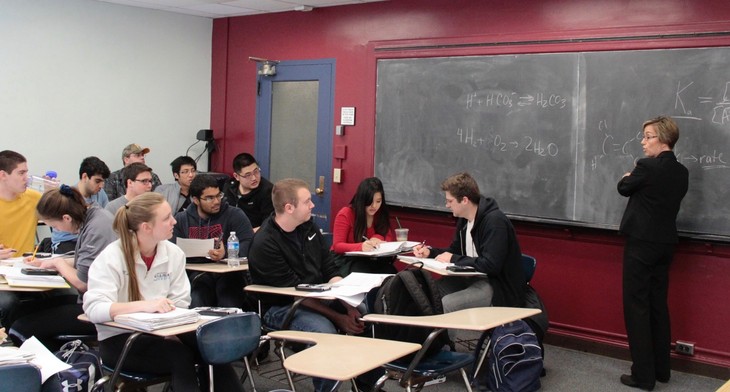¿Cómo afecta la educación de las percepciones de los procesos políticos en los EE.UU.?
Dan Falcone: Estamos aquí de nuevo en el MIT para discutir la educación, la historia y la política con Noam Chomsky. Gracias por tenernos. Me preguntaba si podría hablar sobre algunos de los retos que se escuchan de los amigos que tiene en el campo de la educación?
Noam Chomsky: Un amigo mío estaba haciendo un trabajo interesante en Falmouth. Él trabaja en un sistema escolar de Falmouth. Era un científico cognitivo de Harvard, pero ahora se está trabajando con las escuelas. Comenzó a trabajar con los niños que tienen en una pista especial. Me olvido de lo que ellos llaman, pero los que no están funcionando académicamente. Y cuando comenzó a buscar en ella, se encontró con que estos niños llegan a la escuela en un autobús con tal vez una hora en autobús. Ellos no han tenido el desayuno. Pero cuando entran en la escuela se vuelven locos y empezaron a hacer algunas cosas muy simples como darles caramelos porque descubierto que tienen un nivel bajo de glucosa. Y eso tiene un efecto, y cuando entran en la escuela en lugar de a partir de una clase de matemáticas que sólo los pone en un lugar donde sólo pueden volverse loco y empezar a correr. Ha llegado al punto en que estos niños están superando a los principales los niños en las escuelas principales.
Dan Falcone : Interesante, por lo que sólo a través de técnicas sencillas que ha sido capaz de ayudar a estos estudiantes. El cambio de marchas, quería preguntarle sobre el lugar de las humanidades en la educación. Así, por un lado, veo a esta necesidad de fomentar la creatividad y el desafío que prevalece modelos de negocio de la educación o estrechamiento del molde tecnocrática de la educación –
Noam Chomsky: – Te voy a dar una respuesta. MIT periódico de esta mañana hay un maravilloso artículo sobre la destrucción de la educación en los Estados Unidos, pero son muy optimistas al respecto. Echar un vistazo a los nuevos comandantes.
Dan Falcone: MIT introduce cuatro nuevas carreras, siete nuevos menores. Análisis de negocios, finanzas, economía matemática, de menor importancia en el diseño de la informática, el espíritu empresarial –
Noam Chomsky: Los cuatro carreras: Primera Gestión, Análisis de negocio, finanzas, economía matemática, que es el comercio. Eso es.
Dan Falcone: Sí, he visto este tipo de pensamiento antes. La escuela que yo estoy ahora está cambiando el departamento. Se incluyendo más sujetos de prueba impulsada colocación avanzada, mientras que lo que solía ser un lugar donde se podía ir a –
Noam Chomsky: – Piense en las cosas.
Dan Falcone: Sí, por lo que la otra razón por lo que aparezca, es la otra cara de las humanidades debate con la teoría crítica y estudios culturales, donde hay una tendencia a que la humanidad para rechazar las formas de objetividad o de negar la verdad como una especie de esta moda , de moda entidad, académica mediante la cual termina el poder de refuerzo o hace poco en la forma de contribuir al activismo. ¿Podrías comentar sobre eso?
Noam Chomsky: Es bastante malo aquí, pero el lugar donde es aún más destructiva es en el Tercer Mundo, porque aquí, si los intelectuales simplemente pierden el tiempo, está bien, es importante, pero es posible que no importa mucho. Pero en los países del Tercer Mundo necesitan contribuciones intelectuales más proporcional.
He visto algunos casos sorprendentes. Una vez di una charla en Birzeit, la universidad palestina en Cisjordania, y un amigo mío palestina estaba sentado entre el público. Ellos querían que hable de la situación política actual y por eso me hablaron de ello y como salimos le pregunté a mi amigo lo que su sentimiento era acerca de la reacción de la audiencia [a la charla], y él dijo que estaba sentado al lado de un estudiante que no le gustó mucho.
Ella dijo que era todo acerca de este tipo de negocio anticuado [ingenua] de abrazar la verdad y los hechos y que no es lo que es realmente importante. Y ves que todo el Tercer Mundo. Es una tendencia muy destructivo. Y también es intelectualmente basura pura.
Dan Falcone: Derecha, y muchas veces es bien intencionado, de izquierda personas –
Noam Chomsky: – La gente está bien intencionados pero creo que si nos fijamos en las raíces de la misma – es muy cínico. En su mayoría se trata de París y creo que sobre todo tiene que ver con el colapso de la civilización francesa. Francia no ha sido capaz de llegar a un acuerdo con el hecho de que no es una gran potencia más. Es decir, incluso antes de la Segunda Guerra Mundial de París era uno de los principales centros de la vida intelectual y cultural. Pero ahora París es una especie de filial de Alemania, su enemigo tradicional y que no puede llegar a un acuerdo con él.
Han tratado de crear una cosa loca tras otro para tratar de ser emocionante, cada uno loco más que el anterior, y este es uno de ellos. Y está recogido aquí en su mayoría los departamentos de literatura y algunos departamentos de humanidades. En cierto modo se da la impresión de ser grave. Al igual que usar grandes palabras y frases que tienen complicados y hay cosas que nadie puede entender, por lo que debe ser como los físicos porque no puedo entenderlos y no me puedo entender.
Volver al punto anterior se eleva con respecto al modelo de negocio; en un lugar como el MIT es realmente sorprendente ya que este solía ser una universidad de investigación. La idea de que los niños lo que la conducción es ¿cómo puedo hacer que el dinero es simplemente devastadora, incluso más que el hecho de que no hay ningún comentario al respecto. Mira el comentario del decano [en la prensa del MIT]. Él piensa que es genial.
Dan Falcone: ¿De qué manera los estudiantes reaccionan a esto?
Noam Chomsky: [Las nuevas carreras y selección de cursos] acaba de salir esta mañana [en la prensa del MIT] y yo lo mencionó en una clase de esta mañana. Ellos tipo de pensamiento sobre ello, pero no creo que ellos habrían reaccionado a ella de otra manera.
Dan Falcone: Hace poco vi un amigo suyo habla en Washington DC, Phyllis Bennis, del Instituto de Estudios de Políticas que participaron en la Democracia Despertar. Yo también estaba hablando con Medea Benjamin. Los dos estaban dando una charla sobre la resistencia, la paz, la organización y conseguir dinero de la política. La única cita que dieron fue de Charles Freeman. Es un diplomático estadounidense. Normalmente no oye esas dos diplomáticos citando pero su cotización es, «Estados Unidos se ha comprometido en una guerra fría con Irán, Persia, durante 37 años. Se llevó a cabo diversos niveles de la guerra caliente en Irak durante 26 años. Ha estado en combate en Afganistán para el 15 de América ha bombardeado Somalia desde hace 15 años, Libia para cinco y Siria por un año y medio. Uno de ellos ha dado lugar a otro. Ninguno de ellos ha dado ningún resultado positivo y ninguno muestra ningún signo de hacerlo. En ninguna de estas guerras hay un final a la vista. «Esto es por no hablar de los crímenes israelíes que apoyamos plenamente.
Noam Chomsky: Es interesante desde él, porque es bastante conservadora, pero es un tipo de un pasado de moda, la corriente principal figura del establishment. Ha sido un embajador durante muchos años. Sus actitudes son bastante reaccionaria. Cuando dice que «no ha dado ningún resultado positivo» que significa para nosotros. Nosotros tal vez, las destruimos, pero que se preocupa por eso, ningún resultado positivo para nosotros. Así que el hecho de que personas como él lo están diciendo, y él está muy bien respetados, tiene sentido. Otra es Andrew Bacevich. Es un historiador militar. Él también es bastante conservador, pero se le considera un hombre de izquierda porque dice esto desde la perspectiva de Estados Unidos.
Dan Falcone: Me hizo pensar sobre la guerra global contra el terrorismo y empecé a buscar en un libro de texto y la definición, según prevé el plan de estudios de uso. También traté de rastrear de nuevo para ver lo que los estudiantes estaban aprendiendo previamente por el terrorismo en términos de nuestra guerra contra el terrorismo como se define por los Estados Unidos, Reino Unido y la OTAN como «nosotros contra una fuerza en otro lugar.» Pero, ¿podría usted acaba de hablar acerca de cómo esa definición es complicado y la forma en que no es complicado. Usted ha trazado, desde principios de los 80 y por lo que es una definición bastante fiables en el contexto que lo escribió.
Noam Chomsky: Sí, Reagan inició. Es bastante interesante. Es decir el terror se convirtió en un gran problema cuando la administración Reagan entró. Se anunció de inmediato sus planes [] y el tipo de menospreciado supuestos programas de derechos humanos de Carter. El principal problema es el terrorismo internacional dirigido por el Estado. Justo en ese momento que la gran industria desarrollada. Fue entonces cuando comienza a recibir los departamentos académicos contra el terrorismo. Te dan conferencias de la ONU tratando de definir el terrorismo. Revistas, ya saben, gran explosión de interés en el terrorismo. Empecé a escribir sobre ello más en ese momento al igual que Ed Herman. Pero en realidad había estado escribiendo sobre él antes y nos recogió después de eso.
Pero las cosas que escribimos no puede entrar en el canon por una razón muy simple. Utilizamos las definiciones oficiales de terrorismo. Las definiciones del Código de Estados Unidos, en la ley británica, en los manuales del Ejército de Estados Unidos y así sucesivamente. Y si utiliza esas definiciones se deduce inmediatamente que Estados Unidos es el principal estado terrorista en el mundo. Por lo tanto, ya no se puede tener esa conclusión que tiene que hacer algo más. Y si nos fijamos en todo este trabajo académico en las conferencias y así sucesivamente hay un tema constante que el terrorismo es extremadamente difícil de definir y, por tanto, tenemos que tener un profundo pensamiento al respecto. Y la razón es difícil de definir es bastante simple. Es difícil encontrar una definición que incluye lo que hacen para nosotros, pero excluye lo que hacemos con ellos. Eso es bastante difícil. Por lo que toma una guerra global contra el terrorismo.
Los peores crímenes terroristas que van en este momento son las campañas de aviones no tripulados. Pero no se puede incluir que, obviamente. Así que hay que tratar de definirlo. Quiero decir que si Irán estaba llevando a cabo una campaña de asesinatos matando a cualquier persona alrededor del mundo que cree que Irán podría dañar algún día nos gustaría ir loco. Pero esa es la campaña de aviones no tripulados.
Ha habido un gran problema ahora, desde hace 35 años, en el intento de definir una forma de restringir el concepto de terrorismo a las cosas que los chicos están haciendo para nosotros. Echar un vistazo a la decisión del Tribunal Supremo que autorizó simplemente un esfuerzo por los solicitantes de Estados Unidos contra Irán por actos terroristas. ¿Cuáles son los actos de terrorismo? Los actos terroristas son bombardeos de instalaciones militares estadounidenses en el Líbano y Arabia Saudita, Irán, que se dice que tienen algo que ver con. Bueno supongo que lo hicieron. Ese no es el terrorismo. Quiero decir que si tenemos una base militar en el Líbano que mientras estamos bombardeando los buques de guerra del Líbano, la Marina está bombardeando instalaciones del Líbano y los ataques [alguien que no es el terrorismo].
Pero esa es la manera que tienes para elaborar el concepto y que pasa justo a través de todo el sistema ideológico. Curiosamente tipo de una de las excepciones es la comunidad el derecho internacional. Así que hay un artículo interesante revisión en el último número de la revista American Journal of International Law , un diario muy conservador, que básicamente hace, o se acerca mucho a llamar a la campaña de terrorismo avión no tripulado. Pero no es en la corriente principal del curso o en los libros de texto.
De hecho, si nos fijamos en la guerra mundial contra el terrorismo de Reagan se convirtió rápidamente en una guerra terrorista masivo: [por nosotros] América Central, África del Sur, Oriente Medio, todo terrorismo apoyado por Estados Unidos. Esa es una de las razones por las que desapareció de la historia y por qué la línea estándar es que Bush 43 declaró la guerra contra el terrorismo. En realidad él sólo repitió lo que había dicho Reagan hace 20 años.
Saúl Isaacson: Hablando de presidentes que parece que la mayoría de la gente parece creer que Hillary Clinton es inevitable ahora. Y me pregunto si nos puede dar una visión general de cómo se va a afectar a la situación en Ucrania. La última vez que estuve aquí les preguntó acerca de la declaración de Steven Cohen que teme una confrontación nuclear y la guerra civil. Hillary Clinton será agravar la situación con sus políticas, que parecen a la derecha de Obama, a veces incluso a la derecha de Trump?
Noam Chomsky: Pienso que probablemente será una versión más dura de Obama. Pero es muy grave, la situación de Ucrania. No se trata sólo de Ucrania ahora, es la región del Báltico. Me refiero a que echar un vistazo a toda la frontera entre Rusia y la OTAN. Obama acaba de anunciar recientemente que están cuadruplicando las instalaciones militares de la OTAN en la frontera con Rusia. Los rusos son, por supuesto, reaccionar, y eso es extremadamente tensa. Quiero decir que podría explotar en cualquier momento y todo tiene que ver con la expansión de la OTAN, que está bajo Clinton.
Saúl Isaacson: Parece Clinton quiere tomar ese aún más en el futuro.
Noam Chomsky: Bueno, lo que realmente ocurrió es el primer Bush comenzó moviendo a Berlín Oriental, al contrario de lo que prometieron. Pero entonces, básicamente, Clinton se trasladó todo el camino hasta la frontera rusa y Bush tipo de agregado más. Alrededor de 2008 y nuevamente en 2013 la OTAN ofreció oficialmente Ucrania la oportunidad de unirse a la OTAN. Eso es algo que ningún gobierno ruso es cada vez va a aceptar. Está justo en el corazón geopolítico de Rusia. Clinton supongo que vayan a ejercer supongo que si ella es lo suficientemente loco. Quiero decir que es casi una declaración de guerra. Sé que la gente como George Kennan y otros advirtieron sobre esto enseguida, allá por los años 90.
Saúl Isaacson: ¿Se le frustran que Sanders no habló sobre esto más?
Noam Chomsky: No habla de ello.
Saúl Isaacson: Pero me volvía loco. Parecía que Clinton sería vulnerable en estos temas.
Noam Chomsky: Ella sería vulnerable excepto que es popular. Ya sabes, ¿por qué deberíamos dejar que los rusos salgan con la suya? Echar un vistazo a el pasado domingo en el New York Times Magazine. Se dedica a lo terrible que es Putin. Nos fijamos en Asuntos Exteriores , el principal diario de los asuntos exteriores. La edición actual es casi siempre dedicado a los crímenes de Putin. Y se va todo el camino hasta los periódicos; todo es que los rusos. Seguro que no es un buen tipo, pero el hecho es que es bastante defensiva. Hay un muy buen libro sobre el mismo, un libro muy bueno, de hecho, por un académico británico de Europa del Este, Richard Sakwa, que es el estudio más equilibrado que he visto se llama la primera línea de Ucrania , un libro muy serio.
Saúl Isaacson: ¿Qué pasa con el golpe de Estado en Honduras y el comportamiento de Clinton? No creo que realmente lo etiquetó un golpe de estado. Obama hizo.
Noam Chomsky: Clinton hizo también y el Departamento de Estado de inmediato se trasladó a apoyar al régimen golpista, que nunca llaman un golpe militar, por supuesto, porque eso habría significado cortando los brazos.
Saúl Isaacson: Es diferente. Golpe contra golpe militar. . .
Noam Chomsky: Sí, redactado con decir golpe pero no militar. Había una razón técnica, porque si dicen que llegaron a cortar el flujo de armas.
Saúl Isaacson: Sanders nunca mencionó Honduras.
Noam Chomsky: Se mantiene alejado de la política exterior más o menos.
Dan Falcone: ¿Es prudente?
Noam Chomsky: Creo que es honesto. No creo que le importe mucho. Si nos fijamos en su historial es interno. Comenzó tipo de local en Burlington. Pero los problemas que él habla son básicamente interno y sobre cuestiones internacionales que no ha dicho mucho. De hecho, creo que en toda su carrera no ha hecho mucho.
Saúl Isaacson: Es preocupante en un presidente.
Noam Chomsky: quiero decir que sospecho que no va a ser presidente. Pero si lo fuera, probablemente sería un poco menos aventureros pero creo que el mismo es realmente cierto de Trump. Loco como él es, parece que quiere una especie de América en primer lugar, un enorme ejército, pero sólo para protegernos de todos ellos.
Saúl Isaacson: Él parece tan impredecible, Trump.
Noam Chomsky: Parece muy impredecible.
Saúl Isaacson: Por extraño que a la izquierda de Clinton en algunos temas.
Noam Chomsky: En algunas cuestiones, como el Seguro Social, Medicare. El tipo de vacila.
Dan Falcone: El apoyo que Sanders está generando en los asuntos domésticos proviene de los jóvenes, los ciudadanos más jóvenes, yo diría que indica una buena señal. ¿Está de acuerdo?
Noam Chomsky: Estoy de acuerdo.
Dan Falcone: A menudo es de donde viene todos modos, los estudiantes.
Noam Chomsky: Bueno, de hecho, si nos fijamos en los votantes Trump, se echa un vistazo a sus actitudes no es tan diferente. En algunos aspectos son similares. Son una versión más antigua del pueblo Sanders. Por lo que una gran cantidad de ella es racista y que tienen ese tipo de cosas, pero si nos fijamos en sus puntos de vista sobre decir la salud, educación, etc., es una especie de la misma que Sanders.
Dan Falcone: Y por lo general estos movimientos vienen de los estudiantes, todas las cosas que nos hacen una sociedad más civilizada hacen, a menudo era la gente joven.
Noam Chomsky: Es a menudo proviene de los estudiantes por una buena razón. Ellos, los estudiantes tienen un grado de libertad que nadie más tiene.
Saúl Isaacson: ¿Cree usted que este movimiento es de alrededor de quedarse ahora, el movimiento Sanders?
Noam Chomsky: Creo que mucho de ello depende de él. Me refiero a lo que deberían haber estado haciendo todo este tiempo es una especie de marginar el foco en las elecciones, lo que es secundario, y el uso de la oportunidad de construir o mantener el movimiento en curso que prestar atención a las elecciones durante 10 minutos, pero mientras tanto hacer otras cosas. Ahora es al revés. Todo se centra en la elección. Es sólo una parte de la ideología. La forma en que mantener a la gente fuera de activismo es llegar a todos emocionados con el carnaval que tiene lugar cada cuatro años y luego ir a casa, lo que ha sucedido una y otra vez. La Coalición Rainbow [tuvo este efecto].
Saúl Isaacson: Una cosa que siempre decimos acerca de nuestros estudiantes es que son apolíticos. Sin embargo, esta elección parece desmentir esa idea.
Noam Chomsky: Eso no es una buena cosa porque el tiempo para ser político no es cuando se tiene fiestas y carnavales, que es una especie de espectáculo, de la elección. Afecta a algo, pero no tanto. Y se centra toda la atención en él es que creo un error. No se puede ignorar que, obviamente, y tiene algún efecto. Me refiero a mi sensación es que si algún republicano fue elegido sería casi una sentencia de muerte para la especie, literalmente, sólo a causa de su actitud sobre el cambio climático. Ellos ya están impidiendo cualquier acción a nivel internacional y es por eso que no hay tratado internacional porque están [no votar en ella] en el Congreso, y cada uno de ellos dice que quieren deshacerse de la EPA.
Dan Falcone: Este tópico o concepto que nuestro sistema político es básicamente débil, donde tal vez de vez en cuando es posible que tenga un buen candidato, y es posible que desee incluso votar, pero en general la idea de que los estudiantes ciudadanía asociada con la participación en las elecciones es problemática .
Noam Chomsky: Eso es correcto, esa es la ideología. La ciudadanía significa cada cuatro años se hace una marca en alguna parte y te vas a casa y dejar que otros chicos manejan el mundo. Es una ideología muy destructivo. Mira, los Estados Unidos no tiene partidos políticos. En otros países, tome decir Europa, puede ser un miembro activo del partido político. Aquí, la única cosa en un partido político se está preparando para las elecciones, no las otras cosas que haces. Por lo que es, básicamente, una forma de hacer que la gente objetos pasivos, sumisos.
Saúl Isaacson: ¿Pueden los maestros juegan un papel en la politización de los estudiantes?
Noam Chomsky: Sí. Usted debe enseñar a los niños que las elecciones se llevan a cabo, pero eso no es política. Si usted quiere saber cómo se hace la legislación que no viene de las elecciones.
Incluso la cuestión de la financiación de campaña ha sido un poco engañoso en este sentido. Hay un montón de hablar, ya sabes, ambas partes pasan una enorme cantidad en la financiación de las campañas. Uno de ellos pierde por lo que parece como si hubieran perdido su dinero, pero no lo han hecho debido a que el punto de la financiación es básicamente para comprar el acceso, no necesariamente – que le gustaría tener a ganar su candidato, pero desea acceder. Si saben que los está financiando van a darle tiempo. El tiempo significa que envíe sus abogados corporativos para escribir la legislación que el representante se pondrá en firmar sin leer.
Eso es más o menos la forma en que funciona. Así que la mayoría de los representantes no saben qué demonios está pasando. Son en su mayoría recaudar dinero o besar a los bebés o algo por el estilo. Ellos tienen que firmar la legislación. Su personal puede saber algo de ella, pero su personal está recibiendo la información de los grupos de presión corporativos, que compran el acceso a través de fondos de campaña. El resultado final es conseguir el tipo de legislación que vemos. Creo que todo esto debe ser una parte de civismo, convirtiéndose en un ciudadano, aprender cómo funciona el país.
Saúl Isaacson: Por supuesto que no cuenta con eso.
Dan Falcone: Sí, no es ni siquiera una clase.
Noam Chomsky: No. No ayuda a mantener un trabajo.
Fuente: http://www.alternet.org/election-2016/chomsky-elections















 Users Today : 18
Users Today : 18 Total Users : 35460149
Total Users : 35460149 Views Today : 31
Views Today : 31 Total views : 3418814
Total views : 3418814